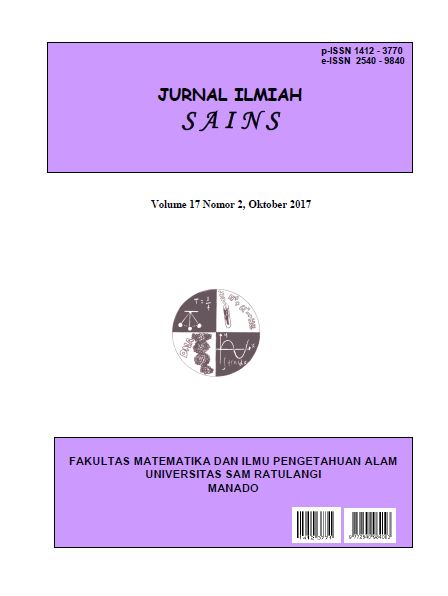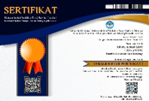ANALISIS POLA KONSUMSI PANGAN DI PROPINSI SULAWESI UTARA
DOI:
https://doi.org/10.35799/jis.17.2.2017.18005Abstract
ANALISIS POLA KONSUMSI PANGAN DI PROPINSI SULAWESI UTARA
Â
ABSTRAKKeragaman pola konsumsi pangan masyarakat pada masing-masing daerah berbeda-beda, tergantung dari potensi daerah dan struktur budaya masyarakat. Pola konsumsi masyarakat Indonesia umumnya masih didominasi oleh padi-padian terutama beras, dan sebagai upaya untuk mengurangi ketergantungan masyarakat pada beras maka perlu menggali potensi lokal yang berbasis non beras untuk memenuhi kebutuhan.Penelitian bertujuan menganalisis kontribusi konsumsi energi dan protein dari berbagai kelompok pangan, menganalisis proporsi sumbangan energi dari beras terhadap total konsumsi energy, dan menganalisis hubungan antara aspek sosial ekonomi keluarga terhadap keaneka ragaman konsumsi pangan (skor PPH).Tingkat konsumsi pangan dikumpulkan dengan metode Recall kemudian dikonversikan dengan ke dalam bentuk zat gizi dengan menggunakan Daftar Komposisi Bahan Makanan (DKBM). Data primer yang lain juga dikumpulkan melalui wawancara langsung dengan informan menggunakan alat bantu kuesioner secara terstruktur. Data sekunder diperoleh dari dari dokumen, laporan, catatan resmi dari instansi terkait sesuai dengan jenis data yang diperlukan. Diperoleh  konsumsi pangan masyarakat Sulawesi Utara berada diatas Angka Kecukupan Energi Ideal sebesar 2.000 kkal/kapita/hari, yakni sebesar 2.021 kkal perkapita perhari., termasuk dalam kategori normal(90-<120%AKE/G), sedangkan Angka Kecukupan Protein mencapai 110,5% yakni 57,5 g/kapita/hari berada diatas angka rata-rata nasional 50,1 g/kapita/hari. Kelompok Pangan padi-padian menyumbangkan energi paling besar yaitu 1166,9 kkal perkapita per hari (58,3 % dari angka kecukupan energi), diikuti Minyak dan Lemak 256,8 kkal ( 12,8 %), Pangan Hewani 212,9 kkal (10,6 %), sayur dan buah 171,0 kkal (8,5 %) dan Umbi-umbian sebesar 64,5 kkal (3,2 %), sedangkan Kelompok Pangan Buah/Biji Berminyak dan Kelompok Pangan Lain-lain menyumbangkan energi paling kecil, masing-masing yaitu 28,2 kkal ( 1,4%), dan 27,5 kkal (1,4%).  Pola Konsumsi Pangan masyarakat masih belum beragam, bergizi dan seimbang. Hal ini ditunjukkan dari skor PPH baru sebesar 89,8 atau kurang dari skor PPH ideal sebesar 100. Aspek sosial ekonomi yang meliputi tingkat pendidikan, jumlah anggota rumah tangga, dan pendapatan rumah tangga menunjukkan tidak terdapat hubungan yang signifikan terhadap tingkat kecukupan gizi (AKE dan AKP). Disarankan perlu upaya promosi kesehatan khususnya mengkonsumsi makanan yang beragam, berimbang, dan bergizi serta mengembangkan sumber karbohidrat umbi-umbian lokal yang potensial, strategis, dan prospektf dalam meningkatkan skor PPH.
Kata kunci : konsumsi pangan, angka kecukupan energi (AKE), angkakecukupan protein (AKP, PPH)
Â
ANALYSIS OF FOOD CONSUMTION IN NORTH SULAWESI PROVINCE
 ABSTRACT
The diversity of food consumption patterns of society in each region varies, depending on the potential of the region and the cultural structure of society. Indonesian people consumption patterns are still dominated by grains, especially rice, and in order to reduce the dependence of the community on rice, it is necessary to explore the non-rice based local potentials to meet the needs. The study aims to analyze the contribution of energy and protein consumption from various food groups, analyze the proportion of energy contribution from rice to total energy consumption, and analyze the relationship between the socio-economic aspect of the family to the diversity of food consumption (PPH score). Food consumption level collected by Recall method then converted into nutrient form using the Food Composition List (DKBM) .The other primary data were also collected through interviewees a direct with the informant using the tool questionnaire structured. Secondary data obtained from the documents, reports, official records of relevant agencies in accordance with the type of data required. The consumption of North Sulawesi people's food is above the Ideal Energy Sufficiency Level of 2,000 kcal / capita / day, that is equal to 2,021 kcal per capita per day, including in normal category (90 120% AKE / G), while Protein Sufficiency Rate reach 110,5% ie 57,5 g / day capital is above national average 50,1 g / capita / hari.Group Grains group donated the most energy, namely 1166.9 kcal per capita per day (58.3 from the energy sufficiency), followed by Oil and Fat 256.8 kcal (12.8%) Hewani Food 212, 9 kcal (10.6%), vegetables and fruit 171.0 kcal (8.5%) and tubers of 64.5 kcal (3.2%), while the Group of Oily Fruits / Grains and Food Groups Others contribute the least energy, each of which is 28.2 kcal (1.4% ), and 27.5 kcal (1.4%). Community Food Consumption Pattern is still not diverse, nutritious and balanced. This is demonstrated by the new PPH score of 89.8 or less than the ideal PPH score of 100. Socio-economic aspects including education level, number of household members, and household income indicate no significant relationship to nutritional adequacy level (AKE and AKP). Suggetions that can be recommended is the need for health promotion efforts in partiqular consume diverse, balanced and nutritions foods, also develop the potential, strategic and perfective root carbohydrate sources in order to increase the PPH score.
Â
Keywords: food consumption, energy adequacylevel (AKE), protein adequacy level (AKP), desirable dietary pattern (PPH)







